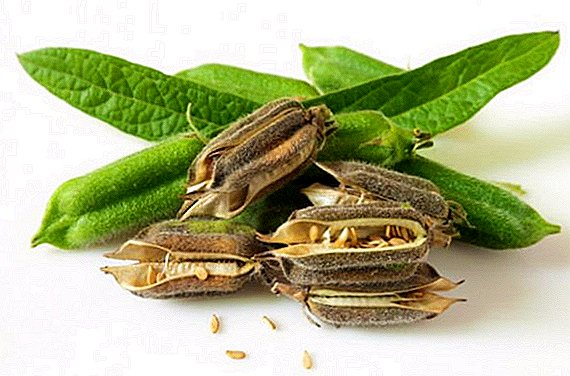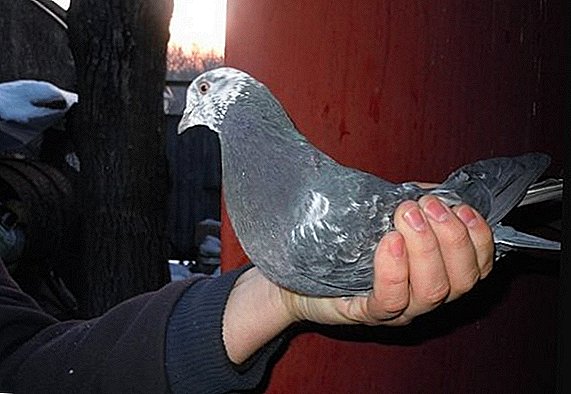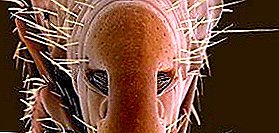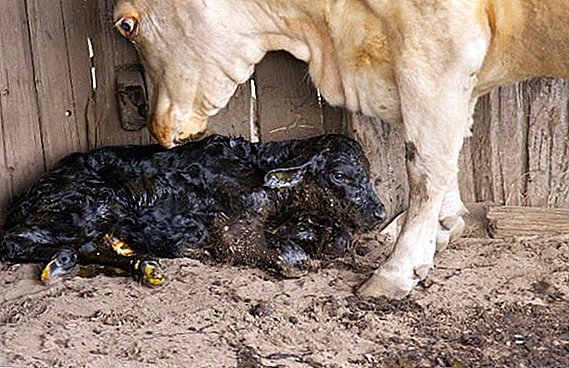 Every livestock breeder from time to time is faced with certain diseases affecting his wards. Of course, the most dangerous of these diseases are infections that can in the short term affect the entire herd, some of which are fraught with mortal danger to humans. Dyspepsia of calves does not apply to such diseases, but it causes great suffering to an animal affected by it, and, if it does not take adequate measures, it can even lead to its death. In order to protect young animals from such problems, it is necessary not only to learn how to recognize them in time, but also to understand what they come from, because it is always easier to prevent the onset of the disease than to treat it.
Every livestock breeder from time to time is faced with certain diseases affecting his wards. Of course, the most dangerous of these diseases are infections that can in the short term affect the entire herd, some of which are fraught with mortal danger to humans. Dyspepsia of calves does not apply to such diseases, but it causes great suffering to an animal affected by it, and, if it does not take adequate measures, it can even lead to its death. In order to protect young animals from such problems, it is necessary not only to learn how to recognize them in time, but also to understand what they come from, because it is always easier to prevent the onset of the disease than to treat it.
What is this disease
The term "dyspepsia" in medicine is used to refer to the so-called functional disorders of the digestive system, that is, such disorders that are not associated with the pathology of a particular organ, but with the incorrect interaction of organs and systems with each other. As a rule, this "imbalance" occurs due to malnutrition or uncoordinated, inadequate or excessive production of enzymes necessary for normal digestion.
Important! Dyspepsia in calves is indigestion (serious problems with digestion and assimilation of food). Pathology is sometimes referred to as “undifferentiated diarrhea,” “enzymatic diarrhea,” or “newborn diarrhea.”It must be said that for a long time dyspepsia was not considered as an independent pathology, it was considered a symptom of one or another disease of the digestive system. However, at present, the position of veterinary medicine has changed, and they speak of dyspepsia only in cases where digestion problems in calves arise against the background of the absence of other pronounced pathologies.

Why do calves?
However, if all the organs and systems in the body work normally, but at the same time the food entering the body is not digested or absorbed, a reasonable question arises as to why this happens. It is believed that the enzymatic diarrhea in calves is caused by dysbiosis, which in turn arises due to the digestive system’s failure to accept the calf of mother's milk (colostrum). Frankly speaking, this justification does not clarify much, but there is no doubt that there is a direct connection between the frequency of dyspepsia in calves and the conditions in which cows are kept and how they feed.
Find out what to do if your calf has diarrhea.
Thus, undifferentiated diarrhea in young animals can occur if:
- during pregnancy, the female cow did not receive adequate nutrition, was deficient in vitamins and trace elements necessary for the normal development of the fetus;
- the cow and the calf are kept in unsanitary conditions, the room is too crowded, cold, hot, humid, dirty, etc .;
- mother and her offspring are not provided with regular walking;
- there is a delay in the first feeding (the calf must be given colostrum during the first 60 minutes after birth);
- the calf receives insufficient or excessive amount of colostrum, or it has a too low temperature, or is stale (sour). This also applies to other feed included in the diet of young;
- Milk obtained from cows suffering from mastitis (a bacterial disease that can cause transmission to the calf) or other diseases, as well as from cows receiving antibacterial drugs, is used for raising young stock;
- young animals are prematurely translated into “artificial” feeding, or concentrated feed is introduced too early in their diet;
- other important technological processes related to the maintenance of animals are disturbed (diet, its composition, quantity, etc.).

All these negative factors lead to dystrophy (underdevelopment) of the gastrointestinal tract in young animals, impaired secretion of digestive enzymes and acid-base equilibrium, loss of beneficial microflora and the appearance of putrefactive bacteria that produce toxins, as well as a general weakening of the immune system, which does not allow the body itself deal with emerging issues.
Did you know? In the old days, when dairy farms did not exist yet, and cows were kept only in private farms, cows fed their calves with milk for up to three years, and functional digestive disorders in young animals were extremely rare. Today, this luxury has become almost inaccessible, the baby is separated from the mother almost immediately after birth, and the milk, instead of its direct appointment, is sent for sale. The dyspepsia of calves, therefore, is the result of human intervention in the natural process of feeding a baby cow.
Very rarely, dyspepsia occurs on the background of autoimmune disorders, that is, due to some kind of malfunction, the defense system begins to destroy not foreign cells, but its own antigens.
How to manifest: symptoms
In its development, diarrhea of newborn calves goes through several stages. So, under the influence of one or another of the above-mentioned reasons, the digestive system of a young animal is gradually disrupted, the microflora from the large intestine moves to the thin one, and the beneficial bacteria are replaced by the disease-causing bacteria, which begin to actively release toxins, the intestinal absorption functions are broken, the production of digestive enzymes is reduced, general intoxication of the body, diarrhea, exhaustion, dehydration, and finally, the disease affects all body systems. At this last stage, the original “normal” form of dyspepsia becomes a more dangerous, toxic form.  It is for this reason that the enzymatic diarrhea is very important to identify in time. This can be done for the following symptoms (their severity and severity increases as the disease progresses):
It is for this reason that the enzymatic diarrhea is very important to identify in time. This can be done for the following symptoms (their severity and severity increases as the disease progresses):
- severe diarrhea - the stool is very liquid, fetid and frequent, almost not ceasing, sometimes involuntary, with a large number of feces of yellow-gray color or just water with bubbles and small lumps of undigested food);
- rumbling in the stomach;
- lack of recruitment or even weight loss;
- loss of strength, lethargy, depression, exhaustion;
- refusal of food;
- involuntary muscle twitching, trembling;
- unstable, reeling gait;
- brittleness and loss of hair (the calf seems disheveled);
- sunken eyes;
- lack of response to touch, light, sound and other stimuli;
- weak pulse;
- heart palpitations, frequent shallow breathing;
- dry nose;
- tearing;
- cold limbs and ears;
- The mucous membranes of the mouth become bluish, and the skin is pale.
Important! The toxic form of dyspepsia occurs in the absence of timely and adequate treatment of the usual form and within 48 hours can lead to the death of the animal.
The calf, suffering from dyspepsia, lies motionless, having turned its head on its side or throwing it back, and occasionally starts, shuffles its hind limbs and groans from agonizing spasms in the intestines. Also, from time to time the baby sniffs his own belly. Pressing on the belly causes obvious painful sensations in the animal, and it tries as much as to resist such manipulations, crawl away to the side or otherwise express its discontent.  The calf's body temperature at the initial stage of the development of the disease usually does not change, but as the condition worsens, it may decrease.
The calf's body temperature at the initial stage of the development of the disease usually does not change, but as the condition worsens, it may decrease.
We recommend to learn how to measure body temperature in cattle.
Diagnostics
The clinical picture of dyspepsia in calves is fairly obvious, and since the disease is in the nature of a functional disorder, its diagnosis does not require any laboratory tests and is based on the analysis of external symptoms.
In fact, some other digestive disorders in calves, in particular, viral diarrhea, colibacteriosis and enterocolitis, have signs similar to dyspepsia, therefore proper diagnosis may be in excluding other diseases, but in practice this method is usually not used, since a wide spectrum antibacterial drugs actions, as well as symptomatic treatment of diarrhea and dehydration, give a positive effect regardless of the causes of digestive disorders in the calf. 
Pathological changes
Accurate diagnosis in this case, as a rule, gives only a pathoanatomical study of the carcass of the deceased animal. In addition to reducing muscle mass and obvious signs of exhaustion, the following characteristic factors are found at autopsy:

- skin is poorly separated from the meat;
- the mucous membrane of the stomach is dry;
- pale hypoderm and similar in texture to jelly;
- the heart muscle is flabby, sometimes slightly enlarged, the epicardial fat on the heart is completely absent, the inner lining of the heart chamber is covered with spot hemorrhages in the form of specks;
- the size of the spleen is reduced, the edges of the organ are pointed, the capsule is difficult to remove;
- hemorrhages are present in the stomach and intestines, reddening in the form of stripes, mucous membranes have signs of edema, lymph nodes are enlarged, a substance similar to cottage cheese is present in the glandular stomach.
Complex treatment of dyspepsia in calves
It should be noted that in itself fermentative diarrhea is not a dangerous disease. The deterioration of the condition of the animal and its possible death arises from complications that accompany the development of the pathology, first of all we are talking about dehydration and intoxication. Therefore, complex and timely therapy, including, along with the use of antimicrobial agents, active prevention of dehydration, has a very favorable prognosis.
Important! The first thing you need to do when you find signs of calf undifferentiated diarrhea is to place it in a separate, warm and dry room, isolated from all relatives, and do not feed for 12 hours, giving only a slightly heated liquid.With obvious signs of poisoning, it is possible to wash the stomach, pouring a weak potassium permanganate solution or a soda solution in a volume from 10 to 20 liters, using the probe, depending on the age of the calf. However, this procedure requires great care and the availability of appropriate skills, so it is usually carried out by a veterinarian.
Regulation of water-vitamin balance in the body
A calf suffering from diarrhea should be watered as often as possible. At the initial stage of treatment it is good to use saline solution or one percent solution of table salt.  Further, it is very important to take care of the compensatory side of treatment: severe diarrhea not only dehydrates the baby’s body, but also flushes out the salts and minerals necessary for the functioning of all organs and systems. Also during this period it is necessary to pay special attention to vitamins. Finally, it is required to restore the disturbed intestinal microflora, restoring the natural balance of good bacteria.
Further, it is very important to take care of the compensatory side of treatment: severe diarrhea not only dehydrates the baby’s body, but also flushes out the salts and minerals necessary for the functioning of all organs and systems. Also during this period it is necessary to pay special attention to vitamins. Finally, it is required to restore the disturbed intestinal microflora, restoring the natural balance of good bacteria.
Important! The calf's diet for dyspepsia must necessarily include all the necessary minerals, as well as vitamins, primarily A, C, D and E.Regulation of water-vitamin balance in the body of a calf suffering from enzymatic diarrhea, is made by feeding the baby:
- ABA preparations (culture of acidophilus bacillus in broth prepared on the basis of whey and animal blood);
- bismuth nitrate;
- carrot juice;
- coniferous tincture;
- decoction of oak bark, horse sorrel, sage leaves, chamomile, St. John's wort, flaxseed, teas and infusions from other medicinal herbs;
- low-fat lactic acid drinks.
Sparing diet
It is equally important to properly feed a calf suffering from an eating disorder. Meals during this period should be carried out gradually, after a 12-hour fasting test, starting at 25% of the normal norm.  The feeding process is carried out 4-6 times a day, and before giving food, the calf needs to be fed with a small amount (up to 100 ml) of a 50% aqueous solution of gastric juice.
The feeding process is carried out 4-6 times a day, and before giving food, the calf needs to be fed with a small amount (up to 100 ml) of a 50% aqueous solution of gastric juice.
Important! Milk sick calves need only milk from the nipples. First, it eliminates the ingestion of additional pathogenic bacteria from a non-sterile bucket, and secondly, independent lacquering is accompanied by swallowing food and air too quickly, as a result of which digestion is disturbed again.
Colostrum before feeding should be heated to room temperature (both hot and cold drinks during this period is contraindicated for the baby). At the initial stage of treatment, colostrum is mixed in equal parts with saline. The volume of the liquid obtained, calculated for one portion, depending on the age of the calf, should be 500-800 ml. If there is an improvement in the condition of the animal, from the third day it can be given undiluted colostrum. Of course, it is very important that it is fresh, and the cow, from which it is received, is absolutely healthy.
Novocain blockade
A one-time injection of a 0.5% solution of novocaine into the abdominal cavity of the calf can quickly stop diarrhea. The injection is made into the right depression located on the abdominal wall near the waist (the so-called “hungry fossa”), to a depth of 2-3 cm. The animal must be in a standing position.  The dosage is calculated based on the weight of the animal (1 ml per kilogram body weight). Often, simultaneously with novocaine, an antibiotic is introduced - penicillin or streptomycin.
The dosage is calculated based on the weight of the animal (1 ml per kilogram body weight). Often, simultaneously with novocaine, an antibiotic is introduced - penicillin or streptomycin.
One of the most common diseases of the digestive tract in calves is colibacteriosis.
Novocaine blocks the inflammatory process in the stomach, while it has the property to be absorbed very quickly, so the effect comes very quickly. But there is one feature: this method gives a positive result in the acute course of the disease, when mild diarrhea is sluggish in nature, novocaine helps badly. Therefore, sometimes the farmer even deliberately worsens the condition of the calf, in order to then provide the animal with quick help. However, like gastric lavage, this operation requires certain skills, so if there is self-doubt, it is better to seek help from a veterinarian.
Electrolytic energy drugs
To prevent dehydration and leaching of important minerals and salts from the body, the animal is prescribed isotonic electrolyte solutions with the addition of glucose. In the mild form of dyspepsia, these drugs are mixed with colostrum or are used in pure form by the oral method (feeding).
In severe cases, dehydration and restoration of electrolyte and energy balance is carried out by intravenous infusion (drip), intraperitoneal or subcutaneous (in the scapula) injection. RThe basic dose of the drug for intravenous administration is 5-10 ml per 1 kg of body weight, for subcutaneous administration - twice as much.  To prepare a therapeutic solution for one liter of distilled water, you must take:
To prepare a therapeutic solution for one liter of distilled water, you must take:
- 50-80 ml of glucose;
- 9 ml of sodium chloride;
- 13 ml of sodium bicarbonate;
- 5 ml of sodium acetate;
- 0.4 ml of potassium chloride;
- 0.3 ml of magnesium chloride;
- 1 g of ascorbic acid.
Already prepared vitamin-mineral, glucose-citrate and electrolyte salt solutions can be used, for example, Ringer-Locke, Anokhin, Nemchenkov, Sharabrin, Porokhova, Kolesov, Mityushin, etc.
To prevent an increase in blood sugar levels and a possible onset of hyperglycemic coma for this reason, in particularly difficult cases, calves are injected subcutaneously with insulin at the rate of 0.5-1 IU per 1 kg of body weight.
Antibiotics and sulfa drugs
Since dyspepsia is accompanied by reproduction of pathogenic microflora in the intestines of an animal, treatment requires the use of antimicrobial and antibacterial drugs. Such drugs are most often given orally in a mixture with food or half an hour before meals, and for the toxic form of the disease, they are administered rectally (candles or sticks). Antibiotics are given to calves very rarely.  Antibiotics and antiseptics give the maximum effect with their combined use. Since the specific causative agent of the disease in this case is unknown (a weakened calf's organism can affect any intestinal pathogens), the use of preparations with the widest possible spectrum of action is most appropriate.
Antibiotics and antiseptics give the maximum effect with their combined use. Since the specific causative agent of the disease in this case is unknown (a weakened calf's organism can affect any intestinal pathogens), the use of preparations with the widest possible spectrum of action is most appropriate.
So, from antibiotics in the treatment of enzymatic diarrhea are used:
- chloramphenicol (chloramphenicol and syntomycin) - 2 mg per 1 kg of mass;
- tetracycline - 1.5 mg per 1 kg of mass;
- polymexins (colomycin) - 1.5 mg per 1 kg of weight.
These drugs should be taken three times a day, but the duration of treatment is always determined by the doctor. As for the antiseptics, these include sulfa drugs group.
Did you know? The first known drug of the sulfa group was streptocid, which, surprisingly, was originally used as a dye. However, in 1932, the German chemist Gerhard Domagk, conducting experiments on mice in search of a remedy for streptococcus, discovered a positive effect from a substance that paints the skin. Perhaps this accidental discovery would be ignored, but soon the daughter of a scientist, unsuccessfully pricked with a needle, almost lost her hand from the onset of decay. Обезумевший от горя отец сделал дочери укол "краски", и воспалительный процесс пошёл на спад.
Streptocide in its pure form is practically not used today (as Dr. Komarovsky wittily remarked, the last microbe that this medicine helps to, died by dying 40 years ago). However, it is replaced by more modern forms of sulfonamides. In particular, for the treatment of dyspepsia in calves, sulfadimine, sulfate, ftalazol, norsulfazole and some others are used.
Folk remedies
There is a mass of recipes for the national treatment of diarrhea in calves, and it must be admitted that with a mild form of dyspepsia they can be quite effective if they are accompanied by a proper diet and the creation of optimal conditions for the sick animal (cleanliness, warmth, rest). However, deciding to do on our own, without resorting to antibiotics, painkillers and other unsafe drugs, it is necessary to carefully monitor the health of the "patient", so that in the absence of a therapeutic effect, have time to provide him with adequate assistance.
Traditional medicine recommends treating enzymatic diarrhea using natural remedies, that is, preparations made from medicinal herbs. These include:
- Onion or garlic infusion (onions or garlic pounded with honey and diluted with saline).
- Broth from onion peel.
- Infusion of legume-cereal seed.
- Grain ash (bread cut, burned in a pan to the coals, then ground, diluted with water and the animal is fed with this homemade solution of "activated carbon");
- Tea mixed with chicken proteins and milk.
- Beet Juice
- Broth or kissel from oatmeal.



Such means are recommended to give to sick calves three times a day 30 minutes before meals at a dosage of 200-250 ml.
Did you know? Interestingly, the cow can be taught to climb the steps, but no force can make her go the same way in the opposite direction.
Prevention
Dyspepsia, like any other functional health disorder, can be prevented. To do this, you just need to follow the following simple rules:
- ensure that the diet of the cow during pregnancy is complete and balanced, including all the vitamins and minerals, as well as other nutrients;
- provide regular veterinary examinations of all members of the herd, conduct timely vaccination;
- Comply with the sanitary and hygienic requirements for keeping cows (do not allow their overcooling, overheating, regularly clean the barn and the feeders);
- provide cows with daily walking in the open air;
- not to use antibiotics to prevent diseases, promote growth and for other purposes that do not correspond to the direct prescription of the doctor;
- give milk to a newborn calf during the first hour of his life;
- not to separate the calf from the mother for at least several days after calving;
- to feed the baby exclusively with mother's milk during the first 10 days of life. If the calf is not in the same stall with a cow, feeding is carried out 6 times a day from a bottle with a nipple. Both the nipple and the bottle must first be disinfected with boiling water.
 Thus, the dyspepsia of newborn calves is not as bad as it may seem. From this disease, the young can die only if its symptoms are ignored for a long time. However, even with a favorable outcome of the disease, babies can still lag behind for a long time, so instead of treating enzymatic diarrhea, it is better to prevent its occurrence.
Thus, the dyspepsia of newborn calves is not as bad as it may seem. From this disease, the young can die only if its symptoms are ignored for a long time. However, even with a favorable outcome of the disease, babies can still lag behind for a long time, so instead of treating enzymatic diarrhea, it is better to prevent its occurrence.We advise you to find out why the calf is sluggish and eats poorly.
To do this, it is sufficient to initially establish the management of your farm in such a way that the cows feel well, receive good nutrition and are kept in comfortable conditions. Then there will be no problems with metabolism and digestion in emerging babies.












